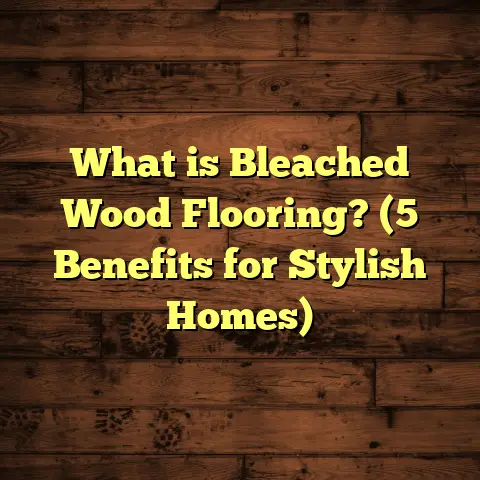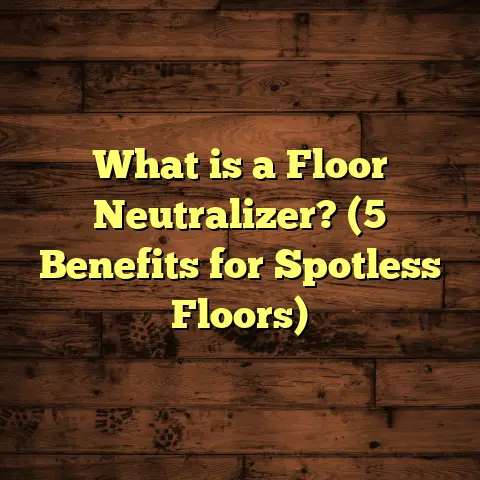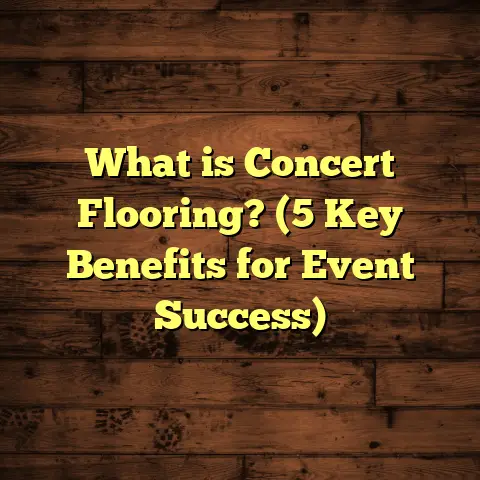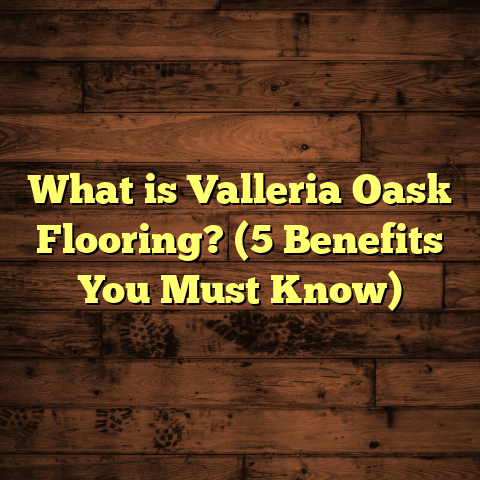What is Horizontal Bamboo Flooring? (4 Benefits You Didn’t Know)
Affordable Flooring That Makes a Difference
I remember when I first started thinking about flooring for my home renovation project. My budget was tight, but I didn’t want to sacrifice quality or style. You hear about hardwood floors being expensive and laminate not always feeling right underfoot. Vinyl can look cheap sometimes, and tile isn’t what I wanted for warm living spaces. As I researched alternatives, horizontal bamboo flooring caught my eye. It was affordable, eco-friendly, and had a unique look that felt both natural and modern.
I bought a few samples to touch and compare, and after installing it in one room, I was hooked. If you’re here reading this, you might be curious about what horizontal bamboo flooring really is and whether it’s worth your time and money. Let me share everything I’ve learned from my hands-on experience, research, and conversations with other flooring pros.
What is Horizontal Bamboo Flooring?
Horizontal bamboo flooring is a type of engineered flooring made from bamboo strips laminated together horizontally to form planks. Instead of stacking strips vertically (which is the vertical bamboo style), the strips lay flat side by side. This technique exposes the natural grain pattern of bamboo in a broad, flowing design.
Bamboo Basics: Not Just Another Wood
Before diving into horizontal bamboo specifically, it’s worth understanding bamboo itself. Bamboo is not wood; it’s a grass. However, it grows tall and hard enough to be harvested and processed into flooring material. One of the biggest draws of bamboo is its sustainability. It can grow to maturity in 3-5 years—much faster than hardwood trees that take decades.
That fast growth means bamboo is a renewable resource that can reduce deforestation impacts. Plus, when processed responsibly, it’s an eco-friendly choice that doesn’t sacrifice durability or aesthetics.
How Does Horizontal Bamboo Flooring Differ from Other Bamboo Styles?
There are three main types of bamboo flooring:
- Horizontal Bamboo Flooring: Strips are glued together horizontally side-by-side.
- Vertical Bamboo Flooring: Strips are glued vertically edge-to-edge.
- Strand-Woven Bamboo Flooring: Bamboo fibers are shredded and compressed with resin under high pressure.
Horizontal bamboo flooring shows more of the natural grain with visible knots and variations since the wide surface exposes each strip’s cross-section. Vertical bamboo has a straighter grain look with fewer knots. Strand-woven bamboo is the hardest but has a more uniform look resembling hardwood.
I’ve installed all three types over the years, but horizontal bamboo stands out for its balance between natural beauty and solid strength.
What Are Horizontal Bamboo Flooring Planks Made Of?
The manufacturing process involves:
- Harvesting: Mature bamboo stalks are cut.
- Stripping: The stalks are cut into thin strips.
- Carbonizing or Natural Finishing: Strips can be heat-treated to darken (carbonized) or left natural.
- Laminating: Strips are glued side-by-side horizontally.
- Pressing: The glued strips are pressed into solid planks.
- Sanding & Finishing: Planks get sanded smooth and finished with sealants or coatings.
The result? A plank that looks and feels similar to hardwood but with distinctive bamboo grain patterns.
Using Horizontal Bamboo Flooring: Where Does It Work Best?
When I first installed horizontal bamboo flooring in my client’s home, she wanted something durable but warm-looking for her family room and kitchen area. I told her horizontal bamboo was ideal because:
- It’s tough enough for moderate foot traffic.
- The warm tones from carbonized finishes add coziness.
- It handles humidity better than traditional hardwood if sealed properly.
Ideal Rooms for Horizontal Bamboo Flooring
- Living Rooms & Bedrooms: Great for comfort and aesthetics.
- Kitchens: Works well if sealed to resist moisture.
- Home Offices: Durable and professional looking.
- Hallways & Entryways: Holds up under foot traffic but may need rugs in wet climates.
- Basements (with Caution): Only if moisture barriers are installed.
In some of my projects, clients asked if horizontal bamboo could handle pets scratching or kids running around. The answer is yes, especially with harder grades and protective finishes.
Not Recommended For:
- Outdoor patios or decks (bamboo isn’t weatherproof).
- Bathrooms with standing water (unless engineered waterproof products are used).
Installation Insights: How I Handle Horizontal Bamboo Flooring Projects
Installing horizontal bamboo flooring feels familiar if you’ve worked with hardwood before. When I took on my own kitchen floor replacement using horizontal bamboo planks, here’s how I approached it:
Step 1: Preparing the Subfloor
The subfloor must be flat, clean, dry, and level within 3/16 inch over 10 feet for best results. I use a self-leveling compound where needed.
Step 2: Acclimation
Bamboo reacts to humidity changes by expanding or contracting slightly. To avoid buckling or gaps later, I always let the planks acclimate in the room for at least 48 hours before installation.
Step 3: Moisture Barrier
For installations over concrete slabs or basements, I lay down a vapor barrier to prevent moisture from seeping up.
Step 4: Installation Method
You have options:
- Nail Down: Good for plywood subfloors; provides stability.
- Glue Down: Especially over concrete; strong bond.
- Floating Floor: Planks click together without glue or nails; faster installation.
For my own home, I used a floating method because it was quicker and less invasive. Floating floors allow slight movement which suits bamboo’s natural expansion.
Step 5: Expansion Gaps
Bamboo needs room to expand, so I leave about a 1/2 inch gap from walls or fixed objects. These gaps get covered later by baseboards or trim.
Step 6: Finishing Touches
Once installed, I recommend applying a high-quality polyurethane finish or using prefinished planks to protect the surface from scratches and moisture.
Maintenance: Keeping Your Horizontal Bamboo Floor Beautiful
One reason I like horizontal bamboo floors is how easy they are to maintain compared to other hardwoods. Here’s what I tell clients:
- Sweep or vacuum regularly to remove dirt and grit.
- Use a damp mop with a cleaner made specifically for bamboo or hardwood floors.
- Avoid excessive water or steam mops that can damage the finish.
- Place felt pads under furniture legs to prevent scratches.
- Clean spills immediately to avoid staining.
In one case, a client spilled coffee on their new horizontal bamboo floor. Because they acted fast and used proper cleaners, no stain set in—proof that this floor can handle everyday life if cared for well.
Four Benefits You Didn’t Know About Horizontal Bamboo Flooring
1. Durability That Surprises Many
People often underestimate how tough horizontal bamboo is. On the Janka hardness scale (which tests wood resistance to denting), horizontal bamboo scores between 1,200 and 1,400 lbf—comparable to red oak (about 1,290 lbf).
This means dents from dropped objects or pet claws are less likely than on softer woods like pine (420 lbf). In fact, I’ve installed horizontal bamboo floors in homes with energetic dogs; the floors held up without major scratches after two years.
2. Carbonized Bamboo Adds Warmth Without Losing Strength
Carbonizing involves heating the bamboo strips to darken them naturally. This produces beautiful warm tones—deep honey, caramel, or rich brown shades—that many homeowners find irresistible.
Even though carbonization reduces hardness slightly (roughly 10-15%), horizontal bamboo still remains durable enough for most residential applications.
I once completed a cabin renovation where we used carbonized horizontal bamboo flooring throughout the living room and kitchen. The warm tones matched exposed wood beams perfectly and created a cozy atmosphere without any compromise in wear resistance.
3. Greater Stability Compared to Vertical Bamboo
The way strips are laminated in horizontal flooring makes the planks more dimensionally stable than vertical bamboo planks.
Why? Because horizontal lamination distributes stresses evenly across the plank width rather than stacking them like vertical planks do.
This means less warping or cupping due to humidity changes—a big plus if you live somewhere with seasonal moisture shifts.
One client in Florida had vertical bamboo floors warp slightly after a particularly humid summer but switched to horizontal bamboo in her next renovation because she wanted improved stability.
4. An Eco-Friendly Choice That Helps Forests
Bamboo grows incredibly fast—some species up to 3 feet per day—and matures in just 3-5 years compared to hardwood trees that take decades.
Because of this rapid growth rate combined with responsible harvest practices, using bamboo flooring helps reduce pressure on old-growth forests worldwide.
Choosing horizontal bamboo flooring supports sustainable building practices without sacrificing style or durability.
Cost Breakdown & How I Use FloorTally for Project Budgeting
Budgeting for flooring can be tricky because prices vary by region, labor rates fluctuate, and waste factors can add unexpected costs.
In several projects involving horizontal bamboo flooring, I turned to FloorTally—a tool that calculates installation costs based on local rates plus material prices—to avoid surprises.
Using FloorTally helped me:
- Estimate total costs including labor, materials, and waste.
- Visualize how different installation methods affect budget.
- Adjust quantities precisely by accounting for waste factors (usually around 5-7%).
- Communicate clear budgets to clients upfront.
For example, one job required about 800 square feet of horizontal bamboo flooring. FloorTally showed me the final installed cost would be around $9-$11 per square foot including labor—significantly less than hardwood alternatives priced at $12-$15 per square foot locally.
Having these numbers allowed me to plan material orders carefully and negotiate better labor contracts without compromising quality.
Personal Stories & Lessons Learned From My Projects
When I installed horizontal bamboo flooring in my own home’s kitchen two years ago, I was amazed at how much it changed the space’s feel. The warm honey color from carbonized planks contrasted beautifully with white cabinets and stainless steel appliances.
The installation went smoothly as a floating floor over plywood subflooring. After sealing it properly with polyurethane coats, it resisted all food spills and foot traffic without any noticeable wear even after daily cooking messes and kids running around barefoot.
Another memorable project was a client who wanted an eco-friendly floor for their nursery. They loved that horizontal bamboo was sustainable yet durable enough for toddler playtime accidents. Six months later they told me how easy cleanup was after spills compared to carpeted floors they’d had previously.
These experiences taught me that horizontal bamboo offers both style and practicality—it’s not just a pretty floor but one that works well for real life.
Frequently Asked Questions About Horizontal Bamboo Flooring
Is Horizontal Bamboo Flooring Waterproof?
Not completely waterproof but water-resistant if properly sealed. You should clean up spills quickly and avoid standing water to prevent damage.
How Long Does Horizontal Bamboo Flooring Last?
With proper care, it can last 20+ years similar to solid hardwood floors.
Can I Refinish Horizontal Bamboo Flooring?
Yes! You can sand and refinish multiple times depending on plank thickness—usually up to three times over its lifespan.
Is It Pet Friendly?
Definitely. Its hardness resists scratches from claws better than many softer woods.
Does It Fade in Sunlight?
Like most natural floors, prolonged direct sunlight can cause some fading or color change over time. Use curtains or UV window films if concerned.
Comparing Horizontal Bamboo With Other Flooring Options
| Flooring Type | Average Cost (Materials + Installation) | Durability (Janka Hardness) | Eco-Friendliness | Maintenance Level | Style Notes |
|---|---|---|---|---|---|
| Horizontal Bamboo | $8 – $12 per sq ft | 1200 – 1400 lbf | High | Moderate | Warm grain patterns; natural look |
| Vertical Bamboo | $7 – $10 per sq ft | 1000 – 1200 lbf | High | Moderate | Straighter grain; fewer knots |
| Strand-Woven Bamboo | $9 – $13 per sq ft | 1500 – 1800 lbf | High | Moderate | Very hard; uniform wood look |
| Solid Hardwood Oak | $10 – $15 per sq ft | ~1290 lbf | Moderate | Moderate | Classic wood grain; versatile |
| Laminate | $3 – $7 per sq ft | Varies | Low | Low | Wide style range; synthetic |
| Vinyl | $2 – $6 per sq ft | Varies | Low | Low | Water-resistant; many designs |
This table helped me explain options clearly when clients were torn between choices. Horizontal bamboo often hits the sweet spot between cost, durability, and sustainability.
Real Case Study: Horizontal Bamboo Flooring in a Family Home
A couple in Oregon hired me to renovate their living room and dining area floors on a budget under $10k total including installation. They wanted something attractive yet kid-proof for their two young kids and dog.
We chose carbonized horizontal bamboo flooring due to its warmth and durability. Using FloorTally estimates helped me keep costs down by ordering precise amounts with minimal waste plus hiring skilled installers at fair prices based on local data.
After six months they reported:
- No visible scratches despite heavy play.
- Easy cleaning after spills.
- Warm feel underfoot compared to tile previously installed.
- Compliments from guests about the unique wood grain look.
This project reinforced my confidence in recommending horizontal bamboo for families seeking affordable long-lasting floors that don’t sacrifice style.
Tips for Choosing Quality Horizontal Bamboo Flooring
When shopping around or ordering online:
- Look for certifications like FSC or Greenguard for sustainability assurance.
- Check plank thickness; thicker planks last longer and can be refinished more times.
- Ask about finish type—prefinished floors save time but onsite finishing can offer customized protection.
- Verify warranty details—good brands offer at least 25 years residential warranty.
- Consider color options—carbonized vs natural tones based on your decor preferences.
Wrapping Up My Thoughts on Horizontal Bamboo Flooring
I’m still amazed how this flooring option combines affordability with durability and style so well. From my own kitchen floor to client homes across different climates—horizontal bamboo has proven itself repeatedly as a smart choice that fits modern lifestyles.
If you want something eco-friendly that feels warm underfoot yet stands up to everyday wear, this might be exactly what you need. Plus, tools like FloorTally make budgeting easier so you know you’re getting value without surprises.
If you want more advice on installation tips or product recommendations based on your space specifics, just ask—I’m happy to help you find the perfect floor!





